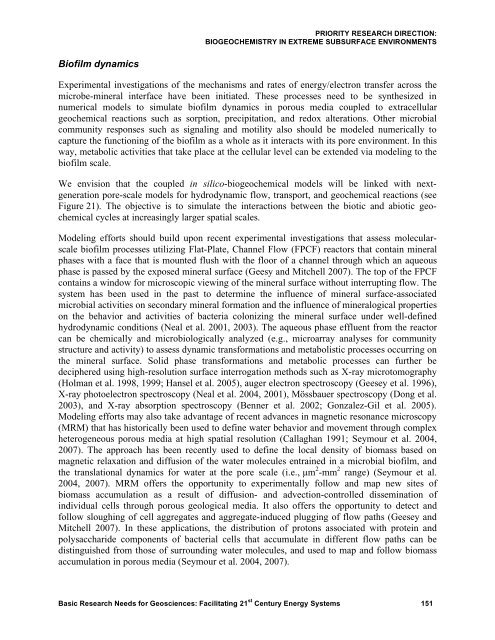Basic Research Needs for Geosciences - Energetics Meetings and ...
Basic Research Needs for Geosciences - Energetics Meetings and ...
Basic Research Needs for Geosciences - Energetics Meetings and ...
- No tags were found...
You also want an ePaper? Increase the reach of your titles
YUMPU automatically turns print PDFs into web optimized ePapers that Google loves.
PRIORITY RESEARCH DIRECTION:BIOGEOCHEMISTRY IN EXTREME SUBSURFACE ENVIRONMENTSBiofilm dynamicsExperimental investigations of the mechanisms <strong>and</strong> rates of energy/electron transfer across themicrobe-mineral interface have been initiated. These processes need to be synthesized innumerical models to simulate biofilm dynamics in porous media coupled to extracellulargeochemical reactions such as sorption, precipitation, <strong>and</strong> redox alterations. Other microbialcommunity responses such as signaling <strong>and</strong> motility also should be modeled numerically tocapture the functioning of the biofilm as a whole as it interacts with its pore environment. In thisway, metabolic activities that take place at the cellular level can be extended via modeling to thebiofilm scale.We envision that the coupled in silico-biogeochemical models will be linked with nextgenerationpore-scale models <strong>for</strong> hydrodynamic flow, transport, <strong>and</strong> geochemical reactions (seeFigure 21). The objective is to simulate the interactions between the biotic <strong>and</strong> abiotic geochemicalcycles at increasingly larger spatial scales.Modeling ef<strong>for</strong>ts should build upon recent experimental investigations that assess molecularscalebiofilm processes utilizing Flat-Plate, Channel Flow (FPCF) reactors that contain mineralphases with a face that is mounted flush with the floor of a channel through which an aqueousphase is passed by the exposed mineral surface (Geesy <strong>and</strong> Mitchell 2007). The top of the FPCFcontains a window <strong>for</strong> microscopic viewing of the mineral surface without interrupting flow. Thesystem has been used in the past to determine the influence of mineral surface-associatedmicrobial activities on secondary mineral <strong>for</strong>mation <strong>and</strong> the influence of mineralogical propertieson the behavior <strong>and</strong> activities of bacteria colonizing the mineral surface under well-definedhydrodynamic conditions (Neal et al. 2001, 2003). The aqueous phase effluent from the reactorcan be chemically <strong>and</strong> microbiologically analyzed (e.g., microarray analyses <strong>for</strong> communitystructure <strong>and</strong> activity) to assess dynamic trans<strong>for</strong>mations <strong>and</strong> metabolistic processes occurring onthe mineral surface. Solid phase trans<strong>for</strong>mations <strong>and</strong> metabolic processes can further bedeciphered using high-resolution surface interrogation methods such as X-ray microtomography(Holman et al. 1998, 1999; Hansel et al. 2005), auger electron spectroscopy (Geesey et al. 1996),X-ray photoelectron spectroscopy (Neal et al. 2004, 2001), Mössbauer spectroscopy (Dong et al.2003), <strong>and</strong> X-ray absorption spectroscopy (Benner et al. 2002; Gonzalez-Gil et al. 2005).Modeling ef<strong>for</strong>ts may also take advantage of recent advances in magnetic resonance microscopy(MRM) that has historically been used to define water behavior <strong>and</strong> movement through complexheterogeneous porous media at high spatial resolution (Callaghan 1991; Seymour et al. 2004,2007). The approach has been recently used to define the local density of biomass based onmagnetic relaxation <strong>and</strong> diffusion of the water molecules entrained in a microbial biofilm, <strong>and</strong>the translational dynamics <strong>for</strong> water at the pore scale (i.e., m 2 -mm 2 range) (Seymour et al.2004, 2007). MRM offers the opportunity to experimentally follow <strong>and</strong> map new sites ofbiomass accumulation as a result of diffusion- <strong>and</strong> advection-controlled dissemination ofindividual cells through porous geological media. It also offers the opportunity to detect <strong>and</strong>follow sloughing of cell aggregates <strong>and</strong> aggregate-induced plugging of flow paths (Geesey <strong>and</strong>Mitchell 2007). In these applications, the distribution of protons associated with protein <strong>and</strong>polysaccharide components of bacterial cells that accumulate in different flow paths can bedistinguished from those of surrounding water molecules, <strong>and</strong> used to map <strong>and</strong> follow biomassaccumulation in porous media (Seymour et al. 2004, 2007).<strong>Basic</strong> <strong>Research</strong> <strong>Needs</strong> <strong>for</strong> <strong>Geosciences</strong>: Facilitating 21 st Century Energy Systems 151
















